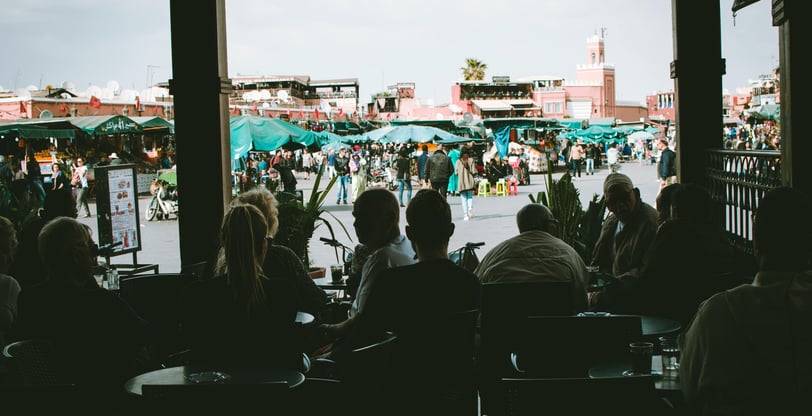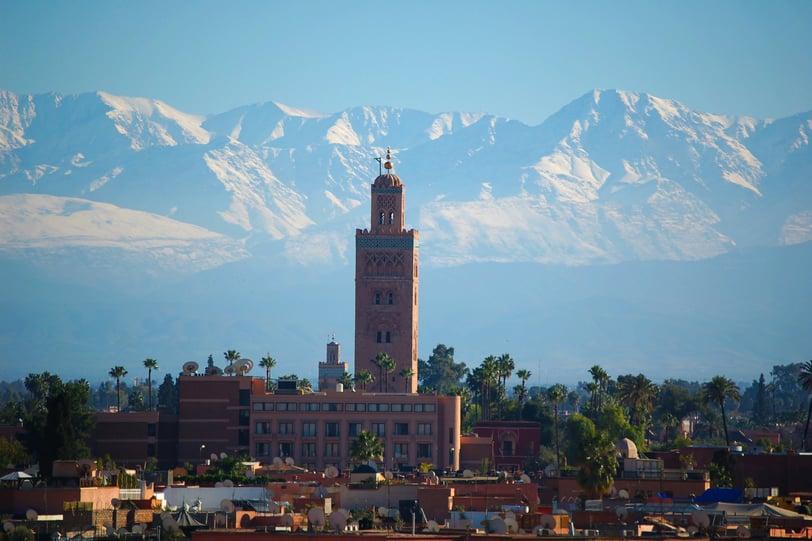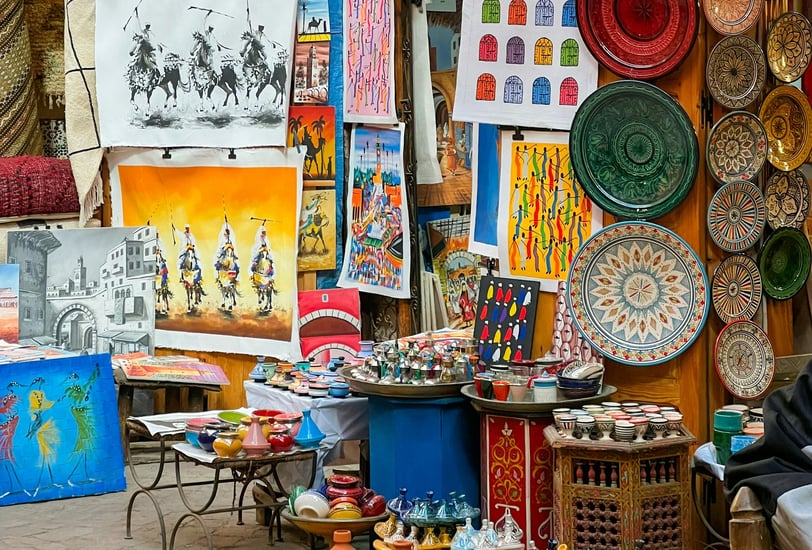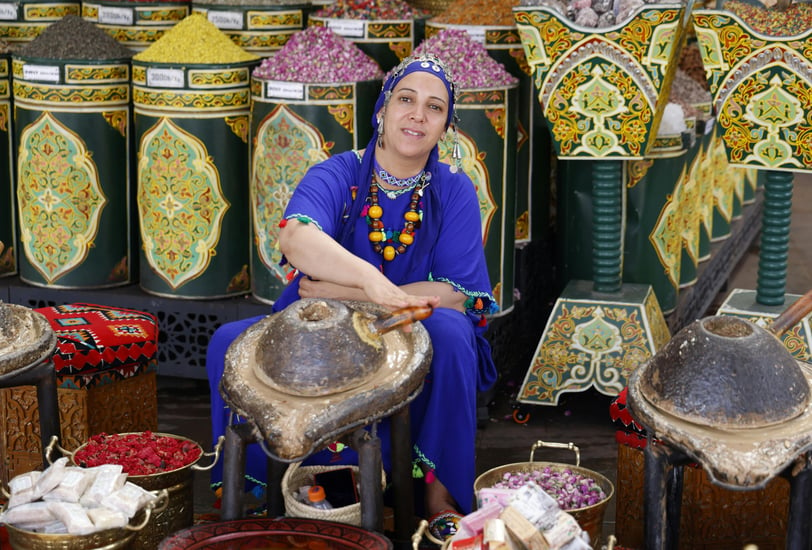Marrakech Travel Tale – When the Sun Lingers at the Minaret's Crown
Jemaa el-Fnaa: A Stage Without a Script
At the heart of Marrakech lies Jemaa el-Fnaa, a square that beats like the city's restless heart.
By daylight, it is an ordinary market — orange juice vendors, herbalists peddling potions, and butchers weighing slabs of lamb on ancient scales. But as the sun begins to tilt westward, Jemaa el-Fnaa transforms into a theater without walls.
Fires bloom in iron braziers. Storytellers gather crowds at the edges, spinning tales of jinns and unrequited love. Musicians pluck oud strings and breathe life into reed flutes, while cobras rise and sway as if bewitched by melodies older than the city itself.
In the corners, women wrapped in dark djellabas offer fortunes with tarot cards. Others weave henna tattoos on the hands of tourists — quick, fleeting art that will fade within days. And always, there are figures moving at the periphery — women with loose veils and soft steps, dancing not for the crowd, but for those who know how to read the language of bodies without words.
It is here that a memory flickers — Malini Angelica, that strange siren from the digital realm. Perhaps women like her have always existed in places like Marrakech, where desire lingers beneath layers of silk and shadow. Women who know that the most potent seduction lies not in what is shown, but in what is withheld.


The ochre walls that wrap around the Medina conceal more secrets than any guidebook could reveal. From a distance, Marrakech appears like a mirage solidified — hot, rippling, and immutable. But once you cross its threshold, you know the city never truly sleeps.
The sun presses against the cobalt sky, melting light onto rooftops and minaret spires. Laundry flutters from narrow balconies, coded signals from lives that do not care for the gaze of outsiders. Dust thickens in the air, carrying the scent of orange blossoms, cedarwood, and sweat — a perfume brewed from both beauty and hardship.
In the labyrinth of alleyways, every turn feels like an accident orchestrated by the city itself. You could follow the fragrance of cumin into a spice shop or let your eyes be caught by brass lamps glinting in dim stalls. There is no map that can chart Marrakech — the only way to know the city is to surrender to its disorientation.


There are cities that wait at the crossroads of destiny — Marrakech is one of them. A city that breathes in murmured prayers and the hush of desert winds, as if time itself moves only by half steps.
The Color That Never Truly Fades
If Marrakech were written in a language, it would be painted in color.
Red — the red of sun-baked walls, of clay rooftops, of raw pomegranates split open at market stalls.
Blue — the deep sapphire of zellij tiles lining hidden courtyards.
Green — fresh mint floating in steaming glasses of tea.
Yellow — the dust of saffron perfuming clay bowls of harira soup.
Yet the most haunting color is the one that cannot be named — the shade of dusk falling over the Koutoubia Minaret. When the sun bleeds into the horizon, the tower glows in a warm copper haze, veiled by a thin wash of indigo — a color caught between fire and shadow.
It is a beauty that can only be glimpsed, never fully possessed.


Women Who Pass Without Names
Women in Marrakech are shadows in constant motion.
They glide through the medina wrapped in black abayas, their eyes hidden beneath embroidered veils. Others wear loose djellabas in the color of desert sand, their faces half-exposed beneath the shade of wide hoods. They rarely speak to strangers, but sometimes — if you are lucky — they will leave behind a flicker of a smile before disappearing into the alleys.
A Moroccan writer once said:
"Women in Marrakech never reveal themselves all at once."
Perhaps that is why they hold such power — because they exist somewhere between freedom and taboo, constantly slipping through the fingers of those who try to possess them.
Beauty Seen Only in Passing
Every journey carries with it a handful of moments that cannot be explained — only remembered.
A woman crossing Jemaa el-Fnaa with a clay jug balanced on her hip.
A flicker of laughter caught from a rooftop café in the fading light.
A belly dancer in a hidden riad, moving slow and sinuous as if her body obeyed the rhythm of the desert itself.
They appear and vanish — lines of poetry never quite finished.
Perhaps that is why women like Malini Angelica ignite such hunger. Because what truly seduces us is not the body fully revealed, but the glimpse that leaves something behind — an ache, a question, a desire that never entirely fades.


Epilogue: The City of Half-Whispered Secrets
Marrakech is not a city for those who seek answers.
It is a city for those who crave unfinished stories.
Its beauty lies in what is hidden — behind wooden doors, behind lattice screens, behind the veil of dusk falling over the medina. Even desire here is spoken in half-phrases, offered only in glances.
If you want to feel that kind of longing, you do not need to go to Marrakech.
Sometimes, it is enough to watch a woman holding a cup of coffee without speaking — and allow yourself to be lost in the silence between her fingers and the rim of the porcelain.
✉️ Contact:
Curated by TrueTrip Hub |
© 2025 Invisible Atlas — All rights reserved.
Invisible Atlas
Journey Beyond the Visible
invisible.atlas@truetriphub.com
